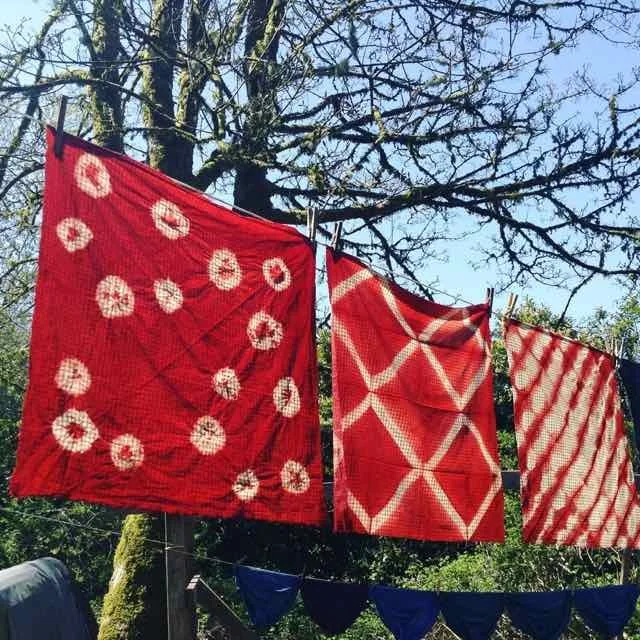Heart of the Madder
Sophie Kanter
Madder is a dye plant whose roots are harvested to create a range of brilliant reds and subtle corals. It is thought to be one of the oldest dye plants that have been used to color cloth. Let’s explore!
The madder plant has green, leafy shoots that grow above the ground and brilliant red roots.
The roots can be used fresh or dried to create a dye bath, and can also be ground into powder to achieve color on cloth. Below is a picture of the beautiful gradient of colors that can be created using madder root.
Image via Catherine Ellis
Archaeological evidence suggests that madder is one of the oldest dye plants to be used practically to color cloth because of fragments of fabric found in the Indus Valley that date back to 3000 BC. That’s a long time ago!! Similar madder-dyed fragments have been found in ancient China. Clearly the madder plant was growing across the globe and was used by several different civilizations in the same applications.
Although we know the madder dye was used, we can’t know exactly what it was meant to symbolize. Throughout history, various plants and their resulting colors have been used to mark territory via clothing or to represent oneself as part of a certain tribe. Perhaps people in these ancient civilizations were using madder-dyed red colors to do the same—to bestow some quality to the wearer, or even to make the clothing sacred.
Above is a microscopic view of a madder-dyed textile found in Israel approximately 3,000 years ago. How cool is that! It is rare to discover ancient pieces of fabric as old as this one because fabric decomposes quickly (comparatively, at least, to things like pottery and metals).
History has seen many incarnations of madder-dyed textiles and the color’s significance, including the robes of Italian cardinals in the 16th century and the (in)famous Red Coat soldiers. In some cultures, it was seen as good fortune for the bride to wear a red dress on her wedding day. Overall, red was seen as the color of royalty or those with high social status.
The Red Coats are probably the most recognizable example of madder-dyed clothing. They wore wool coats that were dyed bright red so that they could stand out on the battlefield.
Whatever side of history you may have been on at the time of the American Revolution, it can be said that the costume choice for the soldiers on the British side was a clever one. In the thick of battle, the air would be heavy with smoke, which would make it almost impossible to see anything, let alone tell the difference between one’s friend and one’s enemy. The literal red coats of their uniform would stand out in stark difference to the white or gray smoky atmosphere. The soldiers could identify those on their side and, to put it plainly, not shoot them. On the other hand, it seems the color would have made them stand out as targets for their enemies as well.
But whatever the case was, the fact of the matter is that there is a long and rich tradition of dyeing with madder, going back to the ancient world. As societies evolved and there was a need for the dyeing of clothing to a) make things beautiful or fashionable, and b) to signify social status or hierarchy. At the time, the only option that people had was to turn to the natural world. The practice of natural dyeing has a much-developed history, so people put that knowledge to practice to make their clothing special in some way.
Image via Dream Bird Studio
When considering your next dye project, perhaps it’s time to dip your hands into madder!
Notes:
In order to use madder in a way that creates long-lasting color on cloth, you’ll need to mordant the cloth before dyeing. See a tutorial here.
I buy my madder root from Botanical Colors.
I have also found that Manjistha Powder can also be used. Common madder dye comes from the plant rubia tinctorum; Manjistha comes from rubia cordifolia. The former is known as “Dyer’s madder,” while the latter is referred to an “Indian madder,” meaning it comes specifically from the country of India. Apparently it has some holistic health benefits, which I have not explored, but it works perfectly for dyeing cloth. The color is almost indistinguishable from colors you’d get from “common” madder.
Happy dyeing!





